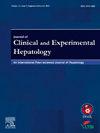Biliary Atresia: A Meta-analysis of Indian Studies
IF 3.2
Q2 GASTROENTEROLOGY & HEPATOLOGY
Journal of Clinical and Experimental Hepatology
Pub Date : 2025-08-28
DOI:10.1016/j.jceh.2025.103156
引用次数: 0
Abstract
Biliary atresia (BA) is a leading cause of neonatal cholestasis and a major reason for pediatric liver transplantation (LT). Despite its clinical importance, research from the Indian subcontinent has historically been sparse and fragmented. Using a Preferred Reporting Items for Systematic Reviews and Meta-Analyses (PRISMA)–guided search, we identified 702 records and analyzed 64 eligible studies, most of which examined clinical features, surgical outcomes particularly after Kasai portoenterostomy, and short-term prognosis. Most existing research remains clinical, radiological, or laboratory based, with considerable variability across findings. Substantial gaps were noted, particularly in understanding disease mechanisms, etiopathogenesis, and diagnostic advancements.
This highlights the need for more focused, conceptually driven, and collaborative efforts. To advance understanding and care of BA in the Indian context, future research must incorporate multidisciplinary approaches, including molecular, genetic, and public health perspectives. By building on the growing interest and solid clinical foundation, India is well positioned to develop a cohesive, forward-looking research framework that addresses current gaps and fosters innovation in the diagnosis, management, and long-term outcomes of BA.
胆道闭锁:印度研究的荟萃分析
胆道闭锁(BA)是新生儿胆汁淤积症的主要原因,也是儿童肝移植(LT)的主要原因。尽管它具有临床重要性,但从历史上看,印度次大陆的研究很少,而且支离破碎。使用系统评价和荟萃分析首选报告项目(PRISMA)引导搜索,我们确定了702份记录并分析了64项符合条件的研究,其中大多数研究检查了临床特征、手术结果(特别是Kasai门肠造口术后)和短期预后。大多数现有的研究仍然是基于临床、放射学或实验室,结果存在相当大的差异。注意到实质性的差距,特别是在了解疾病机制、发病机制和诊断进展方面。这突出了需要更加集中、概念驱动和协作的努力。为了在印度背景下促进对BA的理解和护理,未来的研究必须结合多学科方法,包括分子、遗传和公共卫生观点。通过建立日益增长的兴趣和坚实的临床基础,印度有能力发展一个有凝聚力的、前瞻性的研究框架,以解决当前的差距,并促进BA诊断、管理和长期结果的创新。
本文章由计算机程序翻译,如有差异,请以英文原文为准。
求助全文
约1分钟内获得全文
求助全文
来源期刊

Journal of Clinical and Experimental Hepatology
GASTROENTEROLOGY & HEPATOLOGY-
CiteScore
4.90
自引率
16.70%
发文量
537
审稿时长
64 days
 求助内容:
求助内容: 应助结果提醒方式:
应助结果提醒方式:


